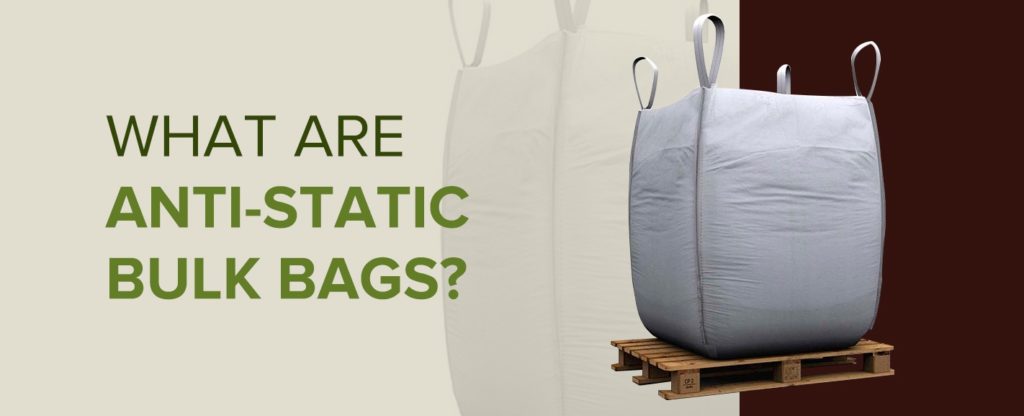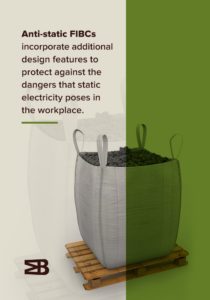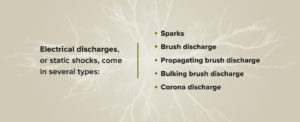
Anti-static bulk bags provide essential tools for transporting materials safely.
According to the Electrical Safety Foundation International, over 2,200 nonfatal electrical injuries took place across America in 2017. These injuries led to a median of 10 missed days of work for each affected employee. Additionally, 1,330 of these nonfatal electrical injuries resulted from shocks — just over 60% of the total.
To increase employee safety and reduce these losses in productivity, it’s important to prevent electrostatic discharge and shocks in the workplace. One way to do this is through the use of specialized bags called anti-static FIBCs.
Because of the protection these bags offer, the market for FIBCs is steadily increasing, currently growing at a 7.3% compound annual growth rate. More and more companies are turning to anti-static bulk bags for the comprehensive protection and peace of mind they offer.
Below, we will discuss different types of bulk bags in more detail and explain the benefits they offer in a variety of applications.
What Are Anti-Static Bulk Bags?
What are anti-static FIBCs, or anti-static bulk bags? They are large transport and storage bags that resist electrostatic charge. Their typical diameter when filled is 45 to 48 inches, which allows the bags to fit two across in a typical shipping container or truck. They are standardized containers and meet ISO standards.
FIBCs, or flexible indeterminate bulk containers, have the following characteristics:
- They cannot be handled manually when they are filled.
- They are intended for the transport of solid material, whether flakes, powder or grains.
- They require no further packaging.
- They are designed for lifting from above by their lift loops or straps.

Anti-static FIBCs incorporate additional design features to protect against the dangers that static electricity poses in the workplace. These special design features allow for the safe discharge of electrical charges. They do this either by conducting electricity to the ground through a grounding cable or dissipating the charge safely into the atmosphere.
Anti-static FIBCs are usually made of woven polyethylene or polypropylene, materials made from petroleum. Their strong loops allow employees to lift them with a loader hook. Employees can also transport the bags using forklifts and pallets.
Anti-static FIBCs are also customizable for different users. Features such as container height, spout diameter and length, whether the fabric is coated or uncoated and whether a polyethylene liner is necessary will vary with different users and applications.
Anti-Static Bags’ Design and Benefits
Anti-static bags offer a few different design options:
- U-panel: A U-panel bag contains one main panel that forms two facing sides and the bottom of the bag, creating a swooping U shape.
- Circular/tubular: A circular or tubular bag is woven on a circular loom. This process eliminates the vertical seams that would typically connect the bag’s sides.
- Four-panel: A four-panel bag is composed of four separate pieces of fabric sewn together.
- Baffle: Baffled bulk bags are the result of sewing extra pieces of fabric over a circular bag. The extra fabric optimizes stability, improves the bag’s appearance and creates a square shape, which allows for more efficient stacking for storage and transport.
Anti-static bags also offer a variety of benefits:
- Convenient shipping. Because of their lightweight construction, they have the lowest package-to-product weight of any intermediate-sized industrial bulk container.
- Convenient handling. FIBCs are easy to transport because of their sturdy lifting loops.
- Easy storage: Lightweight and flexible, FIBCs can be folded, flattened and stowed in small spaces when not in use.
- Variety of applications: FIBCs can be used to transport sold materials ranging from pharmaceuticals to mining products to food products.
- Customizable features: FIBCs’ features can be tailored to a variety of needs, offering numerous options in terms of their size, filling methods, discharging characteristics and more.
- Low ecological impact: When users no longer need their FIBCs, they can recycle them at approved recycling companies across the country.
How Does Static Electricity Work?
We encounter electrostatic charge, or static electricity, in our daily lives. Think about how, after clothes tumble around in the dryer, they come out staticky. Or think about walking across a dense carpet and then receiving a shock when you touch the doorknob.
Static electricity occurs when an imbalance of static charges builds up inside or on the surface of a material. The charges remain imbalanced until they can be released, either through an electric current or through an electrical discharge such as a static shock.
An imbalance of static charges can occur whenever two surfaces contact each other and then move away. When two different materials come into contact, positive or negative electrons can move from one surface to the other, creating a buildup of positive or negative charge. Socks moving across the carpet can cause this effect, and so can clothes tumbling in the dryer. When the materials move apart, the positive and negative charges remain. Eventually, they may release themselves through a discharge of static shock.
Electrical discharges, or static shocks, come in several types:

- Sparks: Incendiary sparks are the leading cause of fires and explosions where static electricity is involved. In the workplace, grounding, both of equipment and employees, who may use protective anti-static straps or wear protective grounding boots, is often essential for the prevention of sparks.
- Brush discharge: Brush discharge occurs when energy is discharged from nonconductive surfaces or even highly charged nonconductive liquids. The energy released under these circumstances is typically modest. A hazardous brush discharge usually involves some combination of high-voltage equipment, a negative surface charge and a flammable environment.
- Propagating brush discharge: This type of discharge occurs when a substantial charge builds up on an insulated surface. Unlike general brush discharge, propagating brush discharge is extremely hazardous because of the high amount of energy involved.
- Bulking brush discharge: Bulking brush discharge, or cone discharge, occurs on the surface of charged dust or powders. The amount of energy involved depends on the magnitude of the charge and the size and volume of the dust particles.
- Corona discharge: Corona discharge occurs when the air surrounding an electrical conductor becomes ionized. Corona discharge is often visible as a bluish glow around electrical equipment. This type of electrical discharge is not typically as hazardous as others, but it does result in overuse of energy and high power costs. In especially high-voltage environments, it can also generate toxic gases.
When employees load, transport and unload bags, conditions are ripe for the buildup of unbalanced electrical charges. The friction of the moving bags against different types of surfaces generates static electricity.
Getting a small electric shock on your finger is unpleasant, but it won’t cause any serious problems. But in industrial workplaces, electrostatic shocks can cause much more significant issues. For example, employees might unload staticky goods into an area where combustible materials are present — say, an abundance of oil or natural gas. The static from the goods could ignite these hazardous materials just by giving off a small amount of electrostatic shock. This risk becomes heightened if the products inside the bags are sensitive chemicals.
To preserve a safe working environment, companies should contain static wherever possible. This is where anti-static bags come in. Anti-static bags help resist and control static discharge. Employees can put goods into electrostatic bags at one location and ship them any distance across the world. When the items arrive at their destination, employees can safely remove them from their anti-static bags.
How Do Anti-Static Bags Work?
Anti-static bags work by inhibiting the effects of electrostatic charge. International standard 61340 regulates the use of anti-static applications, and anti-static bags must adhere to its protocols.
Different types of anti-static bulk bags offer various levels of static protection and discharge. It’s essential to choose the right type of FIBC for each application to ensure that the necessary level of protection is in place.
FIBCs come in types A through D, with type A bags offering no protection against the buildup of static electricity. Type A bags are made of fabric or plastic sheeting without anti-static or anti-combustion properties. Companies can use these bags for nonflammable products, such as foods, in areas where no combustible materials are present.
Anti-static bags come in types B through D:
Type B
Type B FIBCs are composed of materials that have a low breakdown voltage, typically less than 6 kV. This material does not allow for the dissipation of static charge, but it provides limited protection against static electricity. It protects against the risk of sparks and discharges that could potentially ignite fires in the workplace.
The low breakdown voltage of type B FIBCs means companies can use them for dry combustible goods with a minimum ignition energy, or MIE, of less than 3 mJ. These bags are safe for use with such products as long as no flammable gases are present in the environment.
Type C
Type C anti-static bags are made of highly conductive fabric. This fabric is composed of a few types of conductive threads all woven together. It often includes conductive tape as well, which can form either a unidirectional stripe pattern or a bidirectional grid pattern. The conductive strands come together at a single point known as a grounding point.
The conductive properties and grounding capabilities of type C bags mean they can protect against brush discharges and the ignition of incendiary sparks. Because of their grounding abilities, they are optimized for protection against electrostatic dangers rather than for incendiary discharge.
Companies can use type C bags to transport combustible goods, including flammable powders, in areas where flammable gases are stored. However, employees must always take care to ground the bags during filling and emptying. They should not use these bags if no ground connection is present or if it has become damaged.
Type D
Type D anti-static bags are made of a specialized static-resistant fabric interwoven with threads designed to dissipate static and protect against incendiary sparks and brush discharge. They are designed specifically to operate in hazardous situations to maximize safety. Unlike type C bags, they are optimized for protection against incendiary discharge rather than electrostatic dangers.
Type D FIBCs must contain several protective features:
- An insulating layer. This insulating layer is typically a film or lamination on the inside of the container.
- Electrical breakdown voltage of less than 6 kJ.
- Firm contact between multilayered materials to maintain conductivity. This firm contact requires a tightly constructed bag.
- Material consistency. The materials used to create any baffles must be the same materials used for the construction of the main panels.
The construction of type D FIBCs means they have corona discharge properties, or a permanent ability to discharge static. Companies can use these bags without needing to ground them for protection. However, any objects in the environment, such as machines, must be grounded while these bags are in use, and the relative humidity in the environment must remain within specific parameters. The surfaces in the environment must also remain clean and free from conductive materials such as grease and water for these bags to function safely.
Type D FIBCs are some of the most versatile bulk containers on the market for anti-static storage and transport. They are ideal for use in environments containing explosive dust, gases and vapors, and they are suitable for use in nonflammable environments as well.
Type D FIBCs are also less susceptible to human error than type C bags. This is because they do not require internal conductive yarn for interconnectivity or grounding for safe and effective function.
When to Use Anti-Static Bulk Bags
Anti-static bags are appropriate for use with a variety of industrial products, such as agricultural goods, animal feed, chemicals, human food, pharmaceuticals, mining products, recycling waste, tobacco products and more. The bags are available in many different sizes, and certificates of compliance with industrial standards are often available to verify their quality and function.

- For nonflammable food products: For nonflammable items such as bulk food items or pet food bags, type A FIBCs are suitable as long as the environment is free from flammable and combustible materials. Types B through D are also suitable, though they offer more protection than is necessary in this situation. For food items, FIBCs must be clean and composed of nontoxic materials. They should also be woven in clean rooms and manufactured on sanitized machinery. Be sure to buy certified food-grade FIBCs in these circumstances to keep human and animal consumers healthy.
- For dry, combustible goods: For the transport of dry, combustible goods such as chemical powders, type B FIBCs are a suitable choice because of the modest protection they provide against incendiary sparks. As always, type B bags should not be used in environments where combustible or flammable gases are present.
- For hazardous materials: For the transport of particularly hazardous materials, it’s possible to add an extra level of protection through the use of UN-certified FIBCs. These bags are carefully manufactured with safety in mind to protect against all types of leaks and contamination, so they meet the strict construction standards set forth by the United Nations.
- When flammable gases are present: In workplace environments that contain flammable gases such as natural gas or petroleum, type C and D FIBCs are the best choice. For protection against brush discharges and the ignition of incendiary sparks, type C bags are suitable as long as the environment allows for the continual grounding of the bags during filling and emptying. If the environment does not allow for continual grounding, it’s best to use type D bags.
- With liners: Different types of liners are also available for use with anti-static bags. These form-fitted liners are designed to take the exact shape of the bag and enhance filling and discharge. If you use liners, always make sure to choose types that are permissible in combination with your anti-static bags in explosive environments.
Contact Midwestern Bag for Anti-Static Bulk Bags
Figuring out where to buy anti-static bulk bags is easy. Midwestern Bag offers a variety of anti-static bulk bags to help customers find the right fit for every application. We have an outstanding safety record, with over hundred of thousands of our anti-static FIBCs used safely over the decade. We also offer superior construction. Our sturdy construction methods lead to safe, durable bags, and our high-quality baffling designs allow for secure stacking and exceptionally efficient loading capacity.
Midwestern Bag also offers the convenience of buying in bulk. Buying in bulk lowers the price per bag, and it helps you ensure that you always have a supply of bags on hand.
We want to help you find the right anti-static bulk bags for your needs. Contact us today for more information by phone or online, or request a quote.



 Copyright © 2024 Midwestern Bag. All Rights Reserved.
Copyright © 2024 Midwestern Bag. All Rights Reserved.